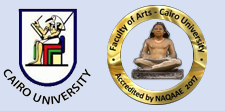عنوان المقال عربي
نقد النصوص العربية المترجمة عن اليونانية ونشرها: القواعد والإشکالات
Document Type
Original Study
Keywords English
Criticism, stemma, critical apparatus, clophon
كلمات مفتاحية عربي
نقد, شجرة المخطوطات, الحواشي النقدية, حرد المتن
Abstract English
The scientific movement began in the Arabic-Islamic civilization in the late Umayyad period, and developed and flourished during the Abbasid period; Thanks to the encouragement of the caliphs, princes and senior statesmen for science and scientists, they took care of establishing schools, libraries, and they also sponsored translators and poured money on them, in return for what they do for translations of Greek, Syriac, Persian and Indian heritage. the result was that the most important books, on medicine, philosophy and other branches of science, were translated from these languages into Arabic. and a huge amount and a huge heritage, which remains in its manuscript form, needs study , textual criticism, and edition. While working in the textual criticism, the editor encounters, at every stage of his work, some problems: some of them are related to collecting copies, examining and arranging them, as well as trying to know the relationship of the manuscripts to each other, to form what is known as the manuscript tree or stemmatology of the tradition, as well as the difficulties related to the scientific content of the text, from such concepts and terminology, including those related to scribes and their errors, including also the physical description of each manuscript and what was called ex libris. as well as We refer to the most important Latin terms used in the textual criticism whenever possible, and identify the differences, wherever they exist, between the Arabic traditions and the Orientalist traditions.
الملخص العربي
بدأت الحرکة العلمية في الحضارة العربية الإسلامية في أواخر العصر الأموي، وتطورت وازدهرت في العصر العباسي؛ بفضل تشجيع الخلفاء والأمراء وکبار رجال الدولة للعلم والعلماء، فاهتموا بإنشاء المدارس والمکتبات ودور العلم المختلفة، کما قاموا برعاية المترجمين وإغداق الأموال عليهم، نظير ما يقومون به من ترجمات لکتب التراث اليوناني والسرياني والفارسي والهندي، وکان نتيجة ذلک أن تُرجمت عيون الکتب في الطب والفلسفة وسائر فروع العلم من هذه اللغات إلى اللغة العربية، وکانت محصلة ذلک کم هائل وتراث ضخم، تبقى في صورته المخطوطة، التي تحتاج إلى الدراسة والنقد والتحقيق والنشر. وأثناء العمل في التحقيق تواجه المحقق في کل مرحلة من مراحل التحقيق، بعض الإشکالات: منها ما يختص بجمع النسخ وفحصها وترتيبها، وکذلک محاولة معرفة علاقة المخطوطات بعضها ببعض، لتکوين ما يعرف بشجرة المخطوطات للنص المحقق، أو إعادة بناء النص. وکذلک ما يتعلق بالمحتوى العلمي للنص من صعوبات، من مثل المفاهيم والمصطلحات، ومنها ما يتعلق بالنساخ وأخطائهم ،ومنها ما يتعلق بالوصف المادي ، وتخريج ما على النسخ من قيود مختلفة وغيرها، مما سوف نطرحه من إشکالات، وکذلک نشير إلى أهم المصطلحات اللاتينية المستخدمة في تحقيق النصوص، کلما أمکن ذلک ونتعرف على الفروق حيثما وجدت، بين التقاليد العربية والتقاليد الإستشراقية.
Recommended Citation
Ǧumʿa, nashwa
(2021)
"Textual Criticism and Text Editing of The Arabic Translated Texts from Greek
Rules and Problems,"
Journal of the Faculty of Arts (JFA): Vol. 81:
Iss.
4, Article 19.
DOI: 10.21608/jarts.2021.88557.1167
Available at:
https://jfa.cu.edu.eg/journal/vol81/iss4/19
Digital Object Identifier (DOI)
10.21608/jarts.2021.88557.1167
Accept Date
2021-10-28
Publication Date
10-1-2021

